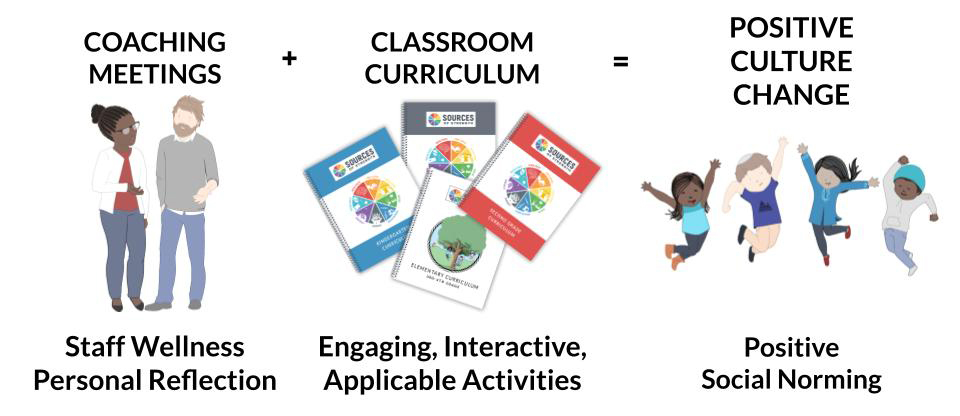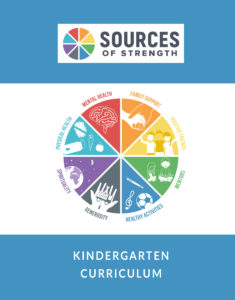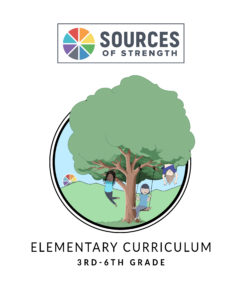Overview
We have heard from our partners across the country about the need for a quality strength-based prevention curriculum at the elementary level. Much of what exists in this space includes solid Social Emotional Learning content but an inadequate focus on mental health or proactive prevention for things like bullying, substance abuse, violence, and suicide.
By moving upstream in the prevention cycle through the Sources of Strength Elementary model, students and adults are invited into creating communities where belonging and connection are the norm, leading to increased purpose and agency, therefore diminishing downstream negative outcomes. Our model moves to increase health and wellness through empowering individuals and communities of belonging and connection to empower a well world.
Elementary Model



Sources of Strength Coaches
We believe that to have maximum impact with students, we need adults who are engaging with and modeling strengths and wellness in their own lives. We are just as focused on supporting and empowering adults as we are with students. To facilitate effective and sustainable implementation, the model includes a two-day Coaches Training to create district and building level buy-in.
This training develops fluency in the content and capacity to coach and support classroom instructors. Training attendees may include classroom teachers, counselors, social emotional learning specialists, school based mental health professionals, and social workers.
Attendees will receive resources to facilitate ongoing coaching meetings, provide professional development sessions for staff, and tools to facilitate ongoing conversations that build staff wellness.
Classroom Instructors
The Elementary curriculum can be lead by the classroom teacher, school mental health staff, paraprofessionals or other adults based upon school context and need.

Curriculum
Sources of Strength Elementary is a Tier 1 universal curriculum for all students grades K-6. Lessons are designed to be approximately 30 minutes in length and delivered once a week. Every lesson incorporates a Talking Circle where students are invited to think, share, and practice building healthy relationships and listening skills as we learn from diverse perspectives. Lessons are interactive with games, emotional regulation practice, and creative expression designed to:
- Increase student and adult connections with one another
- Invite students to identify the Strengths (protective factors) they have in their lives that help them through life’s ups and downs (see Wheel image below)
- Develop understanding of how our brain and body communicate to help us regulate
- Increase emotional vocabulary
- Identify and practice a variety of healthy emotional regulation strategies
- Understand the importance of seeking help for oneself, as well as how we can connect others to help in times of need.
- Empower students and staff alike to be agents of healthy culture change
Sources of Strength Elementary is a universal, classroom-based curriculum, designed to be taught by any adult staff member:
- Classroom teacher
- Social emotional learning specialist
- School mental health professional
- Classroom paraprofessional
Learn more about the Elementary Curriculum:
It is a driving principle of Sources of Strength to incorporate student voice and active engagement with our teaching practices. We believe that the deepest learning occurs when we approach the subject matter from a positive mindset and bring awareness to our Strengths, while also incorporating interactive learning components. This helps people of all ages fully internalize and apply the concepts to their own lives. Lessons at each grade level includes the following core elements:
- Active learning components including art, stories, games, activities, etc. that engage different learning centers of the brain for optimal application and growth.
- Talking Circles to facilitate a collaborative sharing time that fosters connection and empathy, empowers student voice, and promotes equity.
- Guided reflection exercises including breathing, sensory, and mindfulness activities that support self-regulation and self-awareness.
- Celebrations of growth that highlight students’ Strength and skill development while applying a growth mindset.
The Sources of Strengths elementary model is designed to be comprehensive in its positive impact across the entire school’s climate and culture. Traditionally, schools have focused on student safety and support while encouraging the adults to care for themselves on their own time. A truly comprehensive wellness model must include the adults as well. Sources of Strength Elementary addresses this need through Coaching Meetings.
Coaching Meetings are a time during the contracted day specifically for the adults in a school to care for themselves by building deeper and trusting relationships with colleagues, focusing on and sharing what helps them to be healthy, as well as building a practice of self reflection in the area of social and emotional wellbeing. Schools that have implemented the Coaching Meetings have reported the time has been valuable and much needed with the goal of curbing teacher burnout rate, helping with staff retention, and strengthening a healthy staff culture and climate.
This curriculum integrates well with many of the practices and programs that schools are already using, such as Restorative Practices, Mindfulness, PBIS, and more. Each lesson aligns with the Collaborative for Academic, Social, and Emotional Learning (CASEL) core competencies which include relationship skills, social awareness, responsible decision-making, self-management, and self-awareness.

The K-2 curriculum contains 24 lessons per grade level over three units centering on connections and community, engaging strengths, and empowering students to see the ways they can use their voices to make a difference. There is a frequent rhythm of celebration in these grade levels as students are invited to notice and name the positive growth they see in themselves and those around them.

The 3-6 grade curriculum for intermediate grades contains 34 total lessons designed for flexible delivery across multiple grade levels. Each unit concludes with an opportunity to celebrate the growth students see in themselves and those around them.

